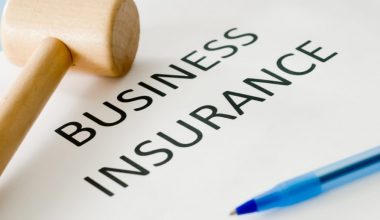When you get a home insurance policy, you receive various benefits, including personal property insurance. Personal property coverage, also known as contents coverage or contents insurance, protects your valuables and is an important component of your home insurance policy. Let’s see what personal property insurance can cover. Read on…
What Is Personal Property Insurance?
Personal property insurance is known as Coverage C in a basic homeowners insurance, renters insurance, or condo policy. It safeguards your possessions (aka the items inside your house). The quantity of personal property coverage provided by a policy varies based on the insurer, but in general, it is a percentage of the amount of dwelling coverage you have. Dwelling insurance, often known as Coverage A, protects your home’s physical structure. As an example, if you have $250,000 in housing coverage and your personal property is set at 50% of that value, you would have $125,000 in coverage.
What Forms of Damage Does Personal Property Insurance Cover?
Each policy has different coverage limits. There are two sorts of homeowners/renters/condo insurance policies: open peril and named peril, and they determine the types of harm for which you are covered.
Policies with specific perils
HO-3 plans are standard homeowners insurance policies that cover personal belongings against specified risks. To file a claim, your goods must have been destroyed by anything specifically mentioned in the policy. These policies mention the following as the 16 most common perils:
- Fire or lightning
- Windstorm or hailstorm
- Aircraft-caused damage
- Explosions
- Riots and civil unrest
- Smoke harm
- Vehicle-related damage
- Theft
- Vandalism
- Objects that fall
- Volcanic eruptive activity
- The weight of snow, ice, or sleet causes damage.
- Overflowing water from plumbing, heating, or air conditioning
- Cracking, tearing, and burning of the water heater
- Electrical current damage
- The freezing of pipes
So if your couch is wrecked due to a busted pipe in the ceiling or your fridge catches fire, you’re protected because these events are recognized as designated risks. However, if a wild animal tore up your living room after you unintentionally left your door open, your property would not be protected because you are not explicitly covered for “wild animal damage.”
In these instances, an “open peril” policy would be required.
#2. Open Peril Policy
Open danger insurance protects your goods from any sort of harm that is not expressly excluded by your policy. Standard homeowners/condo plans often exclude coverage for the following:
- Natural foundation settling, cracking, shrinking, bulging, or expansion
- Earthquakes and flash floods
- Tree roots exert pressure
- Construction flaws
- Insects, vermin, rodents, and animal harm
- Natural deterioration
- Mold
- Corrosion
The burden of proof normally lies on the insurance company, which must demonstrate that the cause of the loss was something expressly excluded from their policy.
For example, you would not be protected if your clothing or furniture were damaged in an earthquake. In our wild animal example, however, you are not explicitly prohibited from an animal wrecking your home. Because the insurance company cannot prove your coverage, you are insured.
What Doesn’t Personal Property Insurance Cover?
Pets and autos are two examples of things that personal property insurance does not cover. Personal property insurance will also not cover losses caused by floods in some cases. If you have boarders, housemates, or tenants living in your home, their items will also be excluded from your home’s insurance coverage. They should consider purchasing their own personal property insurance to cover their possessions in their home.
Jewelry, weapons, cameras, and laptop computers may only have a limited level of coverage under your homeowners’ policy. For example, you may only have up to $1,500 in jewelry coverage for the stolen loss. Other individual things may have special coverage limitations as well. If you want additional coverage for such products, you’ll need to get scheduled personal property coverage.
It is critical to carefully read your policy to understand what is and is not covered, as well as any limitations on coverages and claims.
How Does Personal Property Insurance Work?
When you file a personal property loss claim, the insurance company will pay to repair or replace your damaged belongings in one of two ways: actual cash value (ACV) or replacement cost value (RCV) (RCV). Most companies use ACV by default, but you can choose to cover your personal property using RCV. Personal property settlement is automatically included as RCV by some.
What Is Actual Cash Value (ACV)?
Actual cash value compensates you for the cost of your personal property, less depreciation, and regular wear and tear. For example, suppose you paid $1,000 for a couch four years ago. So, if you make a claim with ACV for a couch that was damaged in a covered loss, the insurance company will deduct depreciation and only give you the value of a four-year-old couch. If the annual depreciation rate is 10%, you’d only get $600 to replace the couch. The settlement amount will be further reduced by your policy deductible.
What Is RCV (Replacement Cost Value)?
Your personal property is protected by replacement cost value at today’s value. Using the same $1,000 couch from four years ago as an example, you would get paid for the cost of replacing it with similar quality and kind of couch. There is no depreciation computation with replacement cost value, but the deductible still applies, reducing the total amount obtained in the loss compensation.
Does Personal Property Insurance Cover Valuables Such as Jewelry?
Yes, your personal property insurance covers items such as jewelry, but there is usually a per-claim limit known as a sublime. So, if someone breaks into your home and steals several pieces of jewelry worth $5,000, and your home insurance policy contains a $1,500 submit for such losses, the most your insurance company will pay is $1,500, less your deductible.
There may be a better approach if you own assets such as jewelry, fine art, guns, or certain collectibles. Many carriers provide scheduled personal property coverage, which can be added to your home’s policy or purchased separately. A valuable item is protected for its full worth when insured under scheduled personal property. To confirm the value, insurance companies often require images of the objects as well as an assessment or expert review per item. Depending on the carrier, you may be required to pay a deductible for this coverage.
How Much Personal Property Coverage Do I Require?
The amount of personal property coverage you require is determined by the type of goods you have, the quantity of them, and the total worth of all your items. Taking an inventory of your home is the greatest approach to appraising all of your personal property.
- Take close-up images or videos of each room in your home. If you’re filming a video, remember to describe each item and its worth as you see it.
- Make a list of all of your valuable possessions, such as furniture. Give each item a monetary value and record identifying information such as serial numbers, the age of the item or the year you purchased it, and the makes and models of computers and other gadgets. When possible, include receipts or valuation documentation like appraisals.
- Give a total price for smaller or bulky products such as cooking utensils, shoes, and clothing.
- When you’re finished, add all of the figures together and round them up to the nearest $5,000 or $10,000. This is the bare minimum of personal property coverage.
So, if that figure exceeds the level of protection provided by your current home insurance policy, you may want to obtain additional coverage. If you have any questions about your policy, contact a certified insurance agent or your insurer.
How Much Are Your Personal Belongings Insured For?
Personal property is typically insured for 20% to 50% of the coverage limits of your home. A typical policy may cover the home structure for $250,000 and personal property for $100,000 (40 percent of the $250,000).
So the amount of coverage you require (and should have) is determined by the amount of property you own and its monetary value.
We recommend completing an inventory of your most precious objects before beginning a policy so you can determine how much coverage you require.
Replacement Cost vs. Actual Monetary Value
If your things are damaged in a covered incident, standard homeowners policies will reimburse you for the actual monetary value of your belongings. However, you get paid for the object up to its present value minus the depreciation. If you wish to be completely covered, you can get replacement-cost value (RCV) coverage, which pays the current market price for an asset. This type of policy will be more expensive.
For example, a TV purchased ten years ago may have cost $1,000 at the time, but it has certainly depreciated and is now only worth $200. After filing a claim, you would only receive $200 with actual cost-value insurance. You would receive the entire $1,000 to replace your TV if you had replacement cost value insurance.
Coverage limit exceptions
Certain “high value” items are not fully reimbursed by homeowners/renters/condo insurance companies.
Jewelry coverage is the best example. Although you may own $20,000 in jewels, conventional insurance policies only cover up to a set amount, such as $5,000. Musical instruments, certain gadgets, and cash are also examples of high-value items.
To insure the full worth of those items, you must normally acquire an endorsement from the insurance carrier to enhance the limits.
How to File a Personal Property Insurance Claim
A personal property claim functions similarly to any other sort of homeowners insurance claim.
If your belongings are destroyed and you believe your insurance company will cover them, you can file a claim online or over the phone. A claims adjuster will arrive to inspect the damage, determine the veracity of the claim, and provide a report to the insurance.
If your claim is approved, you will be paid in two installments. First, the insurance company will decide how much it will cost to repair or replace the object. If you have ACV, you will receive this amount with fewer depreciation costs. RCV will pay you enough money to replace that item at its current market worth. If you have to spend more money than intended to fix the item, the insurance provider may pay you.
Make a point of keeping all receipts and statements. You will also have two years from the date of purchase to replace or repair the item.
How Much Personal Property Insurance Do I Need?
Personal property insurance is typically expressed as a percentage of the total dwelling coverage limit of your homeowner’s insurance policy. You can determine whether or not you need to raise your personal property coverage by conducting an inventory of your possessions and making an estimate of the amount of money it would take to replace those goods. You can determine whether or not you need to add an endorsement for scheduled personal property by inquiring about the policy limit for pricey things with the agent who handles your homeowner’s insurance.
Does Personal Property Replacement Cost Worth It?
That relies on your risk tolerance as well as your financial situation. If you choose actual cash value coverage rather than replacement cost coverage, you may be able to reduce your monthly premium payment by a few dollars. However, if you file a claim and the compensation is less than what you require to replace your possessions, your savings could be completely nullified.
What Types of Damages Does Personal Property Insurance Cover?
In most cases, coverage for the same categories of losses that are included in a conventional homeowners insurance policy is included in personal property insurance policies as well. Standard homeowner’s insurance policies often cover damages brought on by a variety of conventional hazards, such as theft, vandalism, windstorms, fire, smoke, lightning, hail, the weight of ice and snow, explosions, and many more. However, the particulars of the coverage for your personal property insurance will be determined by your policy and any applicable exclusions to it.
What Are Examples of Personal Property Insurance?
In the event of a covered loss, personal property coverage can reimburse you for the cost of repairing or replacing your damaged possessions, such as furniture, clothing, sporting goods, and electronics. This is true regardless of where the damage occurred: in your home, apartment, or anywhere else in the world.
What Are Examples of Personal Property Insurance?
In the event of a covered loss, personal property coverage can reimburse you for the cost of repairing or replacing your damaged possessions, such as furniture, clothing, sporting goods, and electronics. This is true regardless of where the damage occurred: in your home, apartment, or anywhere else in the world.
Summary
Personal property insurance is essential protection for your most valuable belongings that are essential to your way of life. Whether you live in a condo, a house, or an apartment, having the right personal property insurance to cover your needs might help you achieve more peace of mind.
Get a quotation or find an agent if you’re ready to take the next step in insuring your personal property.
Personal Property Insurance FAQs
What are the three most common kinds of property insurance?
The types of property insurance are replacement costs, actual cash value, and extended replacement costs.
What are examples of property insurance?
Property insurance coverage includes homeowners, renters, and flood insurance.
What is not insured by property insurance?
Damage from termites and insects, birds or rodents, rust, rot, mold, and regular wear and tear are not covered. Smog or smoke created by industrial or agricultural operations is likewise not covered. If something is poorly constructed or has a hidden flaw, it is often excluded and will not be covered.
Related Articles
- PERSONAL LIABILITY INSURANCE: Coverages and Costs
- BEST CAR INSURANCE COMPANIES REVIEWS
- SMALL BUSINESS INSURANCE: Overview, Liability, Requirements, Costs
- What Is Car Insurance Premium? Average Costs In 2023
- Cheapest No Down Payment Car Insurance In 2032
- BEST POLICY MANAGEMENT SOFTWARE: 2023 Reviews






